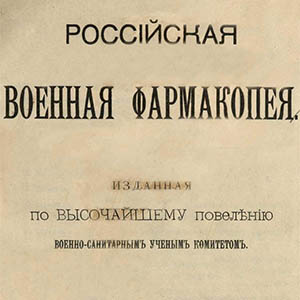
Капли датского короля
Капли датского короля.
Российская военная фармакопея, 1913 год.


Наше предприятие осуществляет заготовку, сушку и реализацию пряно-ароматического и лекарственного…
Европейская Фармакопея издание 7.0 часть 1 2010 год (Ph. Eur. 7.0) стр.1124-1125 Фенхеля горького плоды
01/2008:0824
FENNEL, BITTER
Foeniculi amari fructus
DEFINITION
Dry cremocarps and mericarps of Foeniculum vulgare Miller sp. vulgare var. vulgare.
Content:
— essential oil: minimum 40 mL/kg (anhydrous drug);
— anethole: minimum 60.0 per cent in the essential oil;
— fenchone: minimum 15.0 per cent in the essential oil.
CHARACTERS
Bitter fennel is greenish-brown, brown or green.
IDENTIFICATION
A. The fruit of bitter fennel is a cremocarp, of almost cylindrical shape with a rounded base and a narrower summit crowned with a large stylopod. It is generally 3-12 mm long and 3-4 mm wide. The mericarps, usually free, are glabrous. Each bears 5 prominent slightly carenated ridges. When cut transversely, 4 vittae on the dorsal surface and 2 on the commissural surface may be seen with a lens.
B. Reduce to a powder (355) (2.9.12). The powder is greyish-brown or greyish-yellow. Examine under a microscope using chloral hydrate solution R. The powder shows the following diagnostic characters: yellow fragments of wide secretory canals, often made up of yellowish-brown-walled polygonal secretory cells, frequently associated with a layer of thin-walled transversely elongated cells 2-9 pm wide, having a parquetry arrangement; reticulate parenchyma of the mesocarp; numerous fibre bundles from the ridges, often accompanied by narrow spiral vessels; very numerous endosperm fragments containing aleurone grains and very small calcium oxalate microrosette crystals, as well as some fibre bundles from the carpophore.
C. Thin-layer chromatography (2.2.27).
Test solution. Shake 0.3 g of the freshly powdered drug (1400) (2.9.12) with 5.0 mL of methylene chloride R for 15 min. Filter and carefully evaporate the filtrate to dryness on a water-bath at 60 °C. Dissolve the residue in 0.5 mL of toluene R.
Reference solution. Dissolve 50 μL of anethole R and 10 μL of fenchone R in 5.0 mL of hexane R.
Plate: TLC silica gel GF254 plate R.
Mobile phase: hexane R, toluene R (20:80 V/V).
Application: 10 μL, as bands of 20 mm by 3 mm.
Development: over a path of 10 cm.
Drying: in air.
Detection A: examine in ultraviolet light at 254 nm.
Results A: the chromatograms show in the central part a quenching zone due to anethole.
Detection B: spray with sulfuric acid R and heat at 140 °C for 5-10 min until a yellow zone due to fenchone appears in the lower third of the chromatograms.
Results B: anethole appears as a violet band in the central part. The chromatogram obtained with the test solution also shows a reddish-brown zone in its upper third (terpenes).
TESTS
Estragole. Gas chromatography (2.2.28): use the normalisation procedure.
Test solution. Dilute the mixture of essential oil and xylene R obtained in the determination of essential oil to 5.0 mL with xylene R, by rinsing the apparatus.
Reference solution. Dissolve 5 mg of estragole R in 0.5 mL of xylene R.
Column:
— size: l = 30-60 m, Ø = 0.3 mm;
— stationary phase: macrogol 20 000 R.
Carrier gas: nitrogen for chromatography R.
Flow rate: 0.40 mL/min.
Split ratio: 1:200.
| Time (min) | Temperature (°C) | |
| Column | 0 • 4 | 60 |
| 4 • 26 | 60 → 170 | |
| 26 • 41 | 170 | |
| Injection port | 220 | |
| Detector | 270 |
Detection: flame ionisation.
Injection: 1 μL.
Limits:
— estragole: maximum 5.0 per cent in the essential oil obtained in the assay.
Foreign matter (2.8.2): maximum 1.5 per cent of peduncles and maximum 1.5 per cent of other foreign matter.
Water (2.2.13): maximum 80 mL/kg, determined on 20.0 g of the powdered drug (710) (2.9.12).
Total ash (2.4.16): maximum 10.0 per cent.
ASSAY
Essential oil. Carry out the determination of essential oils in herbal drugs (2.8.12). Use a 500 mL round-bottomed flask and 200 mL of water R as the distillation liquid. Reduce the drug to a coarse powder (1400) (2.9.12) and immediately use 5.0 g for the determination. Introduce 0.50 mL of xylene R in the graduated tube. Distil at a rate of 2-3 mL/min for 2 h.
Anethole and fenchone. Gas chromatography (2.2.28) as described in the test for estragole with the following modifications.
Reference solution. Dissolve 5 mg of fenchone R and 5 mg of anethole R in 0.5 mL of xylene R.
Elution order: the order indicated in the composition of the reference solution. Record the retention times of these substances.
STORAGE
Protected from moisture.